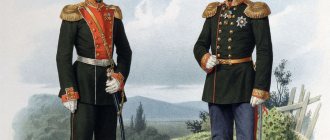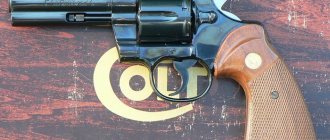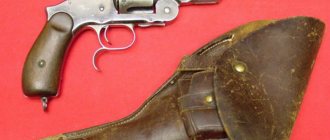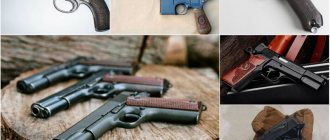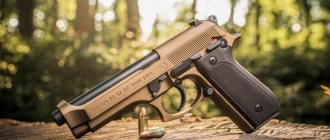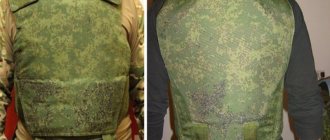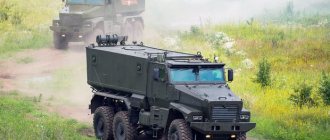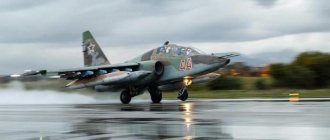Many years have passed since weapons first entered the armies of different countries of the world and law enforcement agencies, gaining a foothold there for a long time. The best pistols in Russia 2021 began their history in 1895, but then it was the development of foreign designers. It was at that moment that the Nagans entered the country. In 1905, already domestic engineer Sergei Prilutsky showed the first example of a self-loading type. For the first time official the best pistol in Russia was invented by 1926 and it belonged to Korovin, hence the name TK. It was assembled in Tula and fired with 6.35 mm cartridges.
Makarova PM
The best pistol in Russia today and it has not given up this position since the Soviet Union. Under the leadership of designer Nikolai Fedorovich Makarov, it was developed in 1948 at the Izhevsk plant and entered mass production in 1951. At the same moment it was adopted by the army and issued to law enforcement officers. Such best pistols in Russia 2022 can truly be considered pride and a huge story. The action of the weapon was based on a free shutter, and locking occurs due to inert mass. Despite its compact size, it still has excellent accuracy. When firing a shot at a distance of 10 meters, the dispersion radius does not exceed 35 millimeters. The top Russian pistol has armed a huge number of countries, it sold like crazy and continues to be popular today.
- Year of creation: 1948
- Caliber: 9 mm.
- Length: 161.5 mm.
- Bullet speed: 315 m/s
- Effective range: 50m
- Magazine: 8 rounds
- Weight: 730 g
Pistols of Russia - expert opinion
There has been a lot of talk about short-barreled weapons lately. Some are dissatisfied with the fact that there are few new models in the modern Russian Army, some scold the old models for their lack of modernity, others, on the contrary, praise them.
The press is fueling interest in short-barreled guns by publishing on the pages of glossy magazines numerous photographs of modern Western pistols from favorable angles, which gives many of our compatriots a nagging feeling of inferiority and backwardness of Russian weapons in all respects.
It’s unpleasant for me when normal people are given falsehoods in a beautiful package, and many are too lazy to learn more broadly and deeply about the history of their weapons, and therefore in this article I will try to reflect the current state of affairs regarding short-barreled guns in the Russian Army and special structures.
So - an army pistol. We'll omit the Nagant and TT. A long and separate story.
Let's start with the Makarov pistol
The Second World War died down. The Cold War and harsh confrontation between the USSR and the West began. Immediately after the Second World War, preparations began for the rearmament of the Soviet Army with new service models of small arms.
The experience of the war, and it was scrupulously studied during that period, showed the extremely insignificant role of the pistol in the combat operations of rifle units. Do not confuse only combat use with the operational use of a pistol in the NKVD - MGB - GRU - Counterintelligence. The pistol has undeniably proven its right to be a truly personal weapon of self-defense and attack for operatives, infantry officers, tank crews, pilots, and naval officers. But he didn’t do the “weather”. By the end of the Second World War, the theory of massive automatic fire from a rifle unit prevailed and the pistol did not fit into it.
In 1945, the GAU determined the performance characteristics of the new pistol and the best gunsmiths of the USSR joined the competition. The pistol was planned to be chambered for 7.62 or 7.65X17 Browning or a new 9 mm cartridge developed by designer B.V. Semin. The new ammunition had less power, but better stopping power, since the 7.62 TT cartridge had the so-called. a sewing effect, when a bullet, having a high initial speed, pierced the soft tissues of the body, and a person in the heat of battle did not even notice it. It was required that one hit was guaranteed to incapacitate the enemy. Therefore, in the end, the leadership of the Ministry of Defense chose the 9 mm cartridge.
A smaller charge of gunpowder made it possible to automate the pistol according to the blowback design. This allowed Makarov to simplify the overall design of the weapon, reducing its weight compared to the TT by 130 g. The overall length was also reduced. It must be honestly said that when adopting the PM into service, many indicators regarding accuracy, accuracy, trigger force and other things had to be sacrificed for the sake of the main indicator that the military sought from designers - reliability.
During field testing, pistols were subjected to sadistic tests, which only the PM completely passed. In addition to Makarov, eight more Soviet designers and, according to various sources, from 5 to 15 pistols of foreign designs took part in this competition. Since it was planned to equip personnel of the Ministry of Internal Affairs and State Security units with this pistol, L.P. himself was personally present at the tests. Beria.
The Makarov pistol, designated PM, was put into service in 1951, although large-scale batches of PMs had been produced since 1949.
What is good about PM and why is it bad for some? Makarov created a truly ingenious design, using Walter’s locking scheme, the simplest and most reliable; in addition, he created an original double-action trigger, the possibility of complete disassembly in the field, an expanded chamber allowing the bolt to insert and remove a rather stubby cartridge without problems of sticking and distortion. A multifunctional safety device that allows, in addition to everything else, to safely remove a loaded pistol from a cocked position. The function, by the way, is available on only a couple or three Western models, and even then it was introduced only in the 70s and 80s.
The gun parts are suspended, which prevents dirt and carbon deposits from accumulating and clogging them. A chrome-plated barrel and very slick contours, which is very important for operational use, does not cling to clothing, and does not injure your hands during use and disassembly. Awesome, incredible resource - up to 50,000 shots. True, this only applies to pistols manufactured between 1955 and the early 70s. years. Since the 80-90s, PM and PMM have been produced of extremely low quality.
High-quality field, naval and operational holsters were made for the pistol and were quite modern for that time. The early ones were made of tarpaulin, later - leather. I’ll also add that the PM is a very fast pistol. He is instantly brought into a fighting position. Can be safely carried with the cartridge in the barrel and the safety off. You need to spend time and learn how to make the first aimed shot by self-cocking, then the rest is not so difficult. My record for rate of fire is 4 targets at 180 degrees, two bullets each, with extraction and first self-cocking shot in 2.1 seconds. A PM magazine can be fired in 1 - 1.2 seconds. I saw such a trick!
At range - I fired from a PM at 100 m at a Pepsi bottle. Three rounds, two hits. But this is just a test of the pistol's capabilities. The straight handle of the PM allows you to shoot intuitively at a chest target up to 15 m. A confident hit, and from a distance “point blank” to 5 - 7 meters, the PM does not need to be raised at all. You can put all the bullets from the hip.
What is “bad” about Makarov? Many users, especially athletes, complain about the heavy trigger release. After sports pistols, of course, it’s a little hard. But not fatal. Just right for a combat model. Without self-cocking, the trigger force of 2.0 to 2.1 kg is quite acceptable for a normal person. Self-cocking up to 4.3 kg, but if anyone has shot self-cocking from a Nagant, he will agree with me that the self-cocking PM is a piece of fluff. An outdated magazine latch, there is such a thing.
Small number of cartridges. (In the PMM model this problem is partially solved). Here I half agree. Multi-shot pistols and a large number of loaded magazines, as is now fashionable in the West, did not lead to increased accuracy of the shooter. This is still a piece item. The emphasis is on massive fire, not accuracy. As the cowboys used to say in the Wild West: If you don't hit with six, you won't hit with thirty-six.
You can shoot from a Makarov at 50 meters only on a dare. In a combat situation this is pointless; 25 meters is already a shot of despair. It is better to use Makarov effectively at a distance from “point-blank” to 15 m. So the PM exactly meets the purposes and combat properties stated in the NSD and is essentially a personal weapon of attack and defense, designed to defeat the enemy at short distances.
In general, the main group of opposition to the PM, as I see it, consists of either athletes or people who have had very little contact with this pistol or have not held it in their hands at all. Many social and political factors contribute to this. In Soviet times, access to military weapons was generally very limited, and bullet shooting was carried out from small guns and Margolin. In the army, pistol shooting gradually turned from the most interesting part of combat training into a routine procedure, carried out once or twice a year before inspections. After perestroika, nothing changed. The old footage remains in place! And with them the same attitude towards fire training.
Now about APS
The Stechkin automatic pistol is also a masterpiece of design thought. First of all, it must be said that to date there are not even five models of this type in the world. And Stechkin was created in the 40s! The APS was put into service together with the PM and AK 47 as a “cartridge-weapon” complex. It must be recalled that in terms of unification of ammunition and small arms, the USSR at one time was far ahead of all countries in the world.
According to the NSD, the APS is also a powerful personal weapon, which combines the combat properties of a pistol and a submachine gun. It is intended to arm officers directly involved in combat operations, as well as sergeants and soldiers of some special units. In my opinion, everything is short and clear. L.P. Beria was also present at the reception of the APS. The pistol also went to the MGB.
A lot has been written about APS, so I will not repeat myself, but will say only a few words from myself. In my opinion, the APS should not have been created automatically. Of course, at that time it was a revolutionary decision, it’s a joke, the officers of such a huge and powerful army are armed with the most modern automatic pistols. Yes, no one in the world dreamed of such a thing! But time puts everything in its place. If the APS were non-automatic, it would be a large, repeating pistol, not much larger than a Colt or High Power. There would be no need to create a bulky wooden holster. Walking, let alone running and overcoming obstacles with such a holster is just torture. It is impossible to quickly bring a pistol into a firing position with a holster. Shoot in bursts or at a distance of 100 and 200 m? Well, this is an extremely rare situation. What remains is the usual pistol range and the use of the pistol for its intended purpose - for self-defense.
Instead, it would be possible to cut a comfortable leather holster similar to the modern PMM holster, where the magazine pocket is moved forward, in place of the cleaning rod. Then the holster would be acceptably flat. Or you can do it without a pocket at all, since a leather case for four magazines was already provided for the APS.
The leather holster looked decent on both the officer’s field and everyday equipment: a belt with a sword belt and a field bag. It will be objected to me that later a silent model appeared - APB, in a leather holster with a frame butt. Yes, it appeared, but as a necessary measure of at least some use of mothballed APS. And again... It doesn’t hurt to shoot in bursts very often from a silent APB either. They stuffed both the stock and the silencer into the holster for the APB and it turned out to be terrible. The main parameters of the APS, even today, are almost equal to the parameters of combat pistols of Western armies. The barrel length of 140 mm allows you to accelerate the low-power 9 X 18 cartridge to an acceptable speed of 340 m/s. For comparison, pistols chambered for 9 X19 Luger have an initial bullet speed of 350 -365 ms.
The 20-round magazine is quite modern. From the APS you can fire single shots with both one and two hands, as is now fashionable. Manufacturers of the field equipment sets that have appeared recently make holsters for APS from synthetic fabrics, integrated for attachment to a waist belt or equipment parts. It's a shame they didn't do this earlier.
Disadvantages: the magazine latch is at the bottom of the handle; reloading requires skill and time. The upper back part of the handle, where the pistol is held by the fork of the thumb and forefinger, is wide and the linings are not rounded. Hence the constant control of the grip, which sometimes distracts from the task. The fuse is far from the thumb and is not as convenient to manipulate as, say, on the PM. Shooting at 100, and even more so at 200 meters, is a far-fetched topic. Apparently they looked up to Mauser. Like, we are no worse. I don’t know of a single case when someone really needed it. Except for the Genghis-Khan Horde going on the attack. Or Indian war elephants.
Otherwise, the APS is an excellent pistol. Following the tradition of Soviet gunsmiths, it is also completely disassembled and assembled in the field. Due to the mass of the bolt and the length of its stroke, the shot from the APS is very soft. Convenient to aim. The aiming line is very large. It is very convenient to equip stores. Almost without looking. Again, the APS has very smooth body contours, is easy to handle, and does not cling to clothing when removed. The pistol has a beautiful bluing finish and is simply aesthetically beautiful!
GSh-18 designed by Gryazev and Shipunov, PYa designed by Yarygin and SPS designed by Serdyukov
In 2003, based on the results of a competition on the theme “Rook”, by Decree of the Government of the Russian Federation No. 166, the following pistols were adopted for service: GSh-18 designed by Gryazev and Shipunov, PYa designed by Yarygin and SPS designed by Serdyukov. Special mention should be made about these pistols because they were all designed for a new type of ammunition. GSh -18 and PYA chambered for 9 x19 Luger 7N21 - a reinforced version of this cartridge. SPS for the new original ammunition 9 x21 (7N29).
The appearance in the West of a new generation of infantry equipment, where a body armor was integrated into the unloading, and many parts of the soldier’s equipment and weapons began to be attached not to the waist belt, but to unloading vests, creating obstacles for bullets, forced designers to turn to more powerful ammunition and, as a result, to new design of automatic pistols. All three pistols have modern double-row magazines with 15-18 rounds of ammunition. All these pistols are automatic, based on the principle of a short barrel stroke. The magazines are secured with clamps located at the base of the trigger guard, like most modern pistols.
On PYa and SPS USM double action, on GSh-18
The USM is similar to the Austrian striker-fired Glock. In addition, the GSh-18 locks the barrel by turning the barrel 18 degrees. There are 12 lugs on the barrel. These bells and whistles prevent the GSh-18 from becoming a full-fledged pistol, since it has a lot of childhood diseases and their treatment is delayed. Weapon designers want to have their say in the design of the weapon, but this does not improve the design. GSh-18 is a regular participant in international arms salons, but things don’t go any further.
Manufacturers claim that if it is put into production, it will cost less than PM. I don’t know... In 2005, I shot from a general gun at a shooting range near Moscow. None of the three pistols completely fired even one magazine. So it’s too early to form an opinion about the General Staff.
PYA 6P35
- Yarygin pistol. This one was luckier. It reached mass production, which was greatly facilitated by its international certification as a sports serial pistol. For the army, the PYA is manufactured with a metal frame, for export (Viking MP-644), with a polymer frame. There are still minor differences, but they are not fundamental. Starting in 2004, I had to shoot a lot from this pistol at shooting courses, and later I bought my own personal copy.
Positive points: Very comfortable handle. I don’t even know what to compare it with. The gun literally sits in your hand. Convenient sighting devices. The mechanics of the trigger are very interesting. Eliminates twitching. The descent, even with self-cocking, despite the great effort (7 kg!!!), is very smooth. The pistol is accurate. The barrel is weighted like a sporting Colt. Doesn't throw up. Again, at competitions, I shot from my Viking along with all the foreigners. Magazine for 17 rounds. Double-sided safety. Removing the magazine is convenient.
Flaws. On the first models, the cartridge case was extracted straight up, like on a PPSh, and if you shot from the chest or below, it flew straight to the forehead. Very unpleasant. Later the extractor was moved to the right. The safety lever is very small and tight. Horizontal notches cut fingers. I have to put on a band-aid. The overall finish is very rough. A lot of parts need to be sanded. The magazine lips are not processed. This is the only way to cut fingers. The magazine covers are made of brittle plastic. They split on the first day. I had to sharpen the aluminum ones. The Teflon coating on the shutter begins to peel off within the first month of use. A holster for the PJ, it seems, is not even provided. Haven't seen it anywhere.
THX
. Or “Vector” or “Gyurza” for the export version. A modern, powerful army pistol of the latest generation. Its competitor can only be the Belgian Five - Seven. The pistol has several patented innovations. Locking unit, so-called return spring stop, which allows you to exclude from the design the under-barrel rod with a return spring as on the TT, Colt, PYa and put the spring directly on the barrel, as on the PM and APS. The new ammunition for which SPS was developed is 9 X 21 mm. Very powerful. It pierces a 4 mm steel plate at 100 m.
Positive points. Very comfortable in the hand. Unexpectedly easy descent. Only 1.5 kg. It hits extremely accurately, despite the powerful cartridge. The aiming organs are large, like on a Glock. According to stories, this pistol appeared in Chechnya.
Flaws. The safety is on the rear of the pistol grip. Like an ultrasound. Why is he needed there? Unclear! With a small hand, or in an emergency situation, it may be underpressed and the shot will not fire. And, again, low assembly and manufacturing culture. The cartridge for the SPS is a rare curiosity and, according to my inquiries, no one has been able to shoot enough of it to get a feel for the weapon. Two combat magazines are enough.
PSM
. The pistol was created in the late 70s and chambered for the original 5.45 cartridge. Despite the standard blowback-based automatic action, the pistol is a very original design. If you take it apart, you wonder how the designers were able to assemble the mechanism in such a small volume. The width of the pistol is 1.8 cm. Despite its small size, the pistol is evil. The initial speed of the bullet is 315 m/s, the bullet has a steel core and for self-defense it is a very convenient, invisible weapon. More suitable for operational wearing and use. It is not worth using it as an army officer's pistol.
The pistol, following Soviet tradition, is completely disassembled and assembled using a drift and a screwdriver. True, it’s not as easy as PM and APS. Doesn't have a well-thought-out and well-made holster. The regular one is very inconvenient and fearful. Currently, people use self-made, or home-made cooperative production, produced for the gas analogue of PSM - Iceberg.
Since the late 80s, it has become fashionable to give PSM as a reward; they began to produce it in beautiful boxes, with wooden cheeks, etc. But the quality of these pistols is poor. PSM has one psychological drawback, which I heard about from people who used PSM in a real situation. You can't scare people with this gun. He is not taken seriously because of his size. Everyone who took out PSM in order to exert a psychological influence on the enemy had to open fire, since the “client” was not at all afraid of him and continued to press.
So, to date, the Russian Army officially has as many as six pistols and their modifications. And this is not counting the arsenal of special and silent weapons. All samples are DOMESTIC!!! production.
Great America has been unable to give its army ANYTHING for a hundred years except the damned Colt, and since the late 70s of the last century, the American army has been armed exclusively with European pistols: Beretta, Sig Sauer, Heckler Koch.
It's a sin for Russians to complain! God grant that the existing models in service are mastered properly. The other, most important aspect of this issue is fire training, i.e. How the issue of pistol shooting training is posed in Russia today. I won't comment on anything. This is a completely different story and has nothing to do with hardware.
Stechkina APS
The automatic most powerful pistol in Russia 2021, which is widely popular and in demand. Under the leadership of Igor Yakovlevich Stechkin, the weapon was developed by 1948, and already in 1951 it entered mass production. Its main purpose was to arm officers, soldiers, crews of vehicles, ships, and sergeants. It soon became clear that it was also perfect for self-defense. Like many other Russian pistols for long; it was removed in 1958, but is still in service. Today it can be seen in new versions of Stechkin, no less cool.
- Year of creation: 1948
- Caliber: 9 mm.
- Length: 225 mm.
- Bullet speed: 340 m/s
- Effective range: 50m
- Magazine: 20 rounds
- Weight: 1020 g
Weapon Selection
The idea of a compact and effective close-combat firearm appeared with the invention of gunpowder. Solving the problems of increasing the rate of fire, range and accuracy of fire, compactness and ease of use, gunsmiths created real masterpieces. Among them, samples created by masters from Tula and the Urals look quite decent. Russian pistols have always had qualities that distinguished the best models of small arms: reliability, ease of care and maintenance, low cost of mass production and special aesthetics.
By the beginning of the 20th century, the basic principles of the purpose, layout and design of firearms for firing at short (up to 50 m) distances had been established and were adopted by all the main participants in the hand-held weapons market. Russian pistols, like European and American systems - “Colt”, “Walter”, “Browning”, “Luger”, “Smith and Wesson”, etc. - were supposed to be light in weight, allowing them to carry the weapon with them effortlessly, fire with one hand, do not waste extra time preparing for shooting.
Tula Tokarev TT
When remembering all the pistols in Russia 2022, we must not forget about the legendary TT, which absolutely everyone knows. The model was launched into production by Fedor Vasilyevich Tokarev in the 1930s, and over the entire period it was possible to create at least 1.8 million units. Thus, this weapon is already more than 90 years old and not so far from being a hundred years old. The channel locking design is exactly the same as the Browning. The most powerful self-loading pistol in Russia , it is very convenient. The design itself is simple, which is why it is so easy to maintain. The muzzle energy of the TT reaches 500 Joules, it is very penetrating. In terms of security, it cannot be called the best.
- Year of creation: 1930
- Caliber: 7.62 mm.
- Length: 195 mm.
- Bullet speed: 420 m/s
- Effective range: 50m
- Magazine: 8 rounds
- Weight: 854 g
Yarygina "Rook"
Russian pistols 2021 have never stopped in production; “Rrach” is one of the newest models, adopted for service already in the 2000s. Designer Yarygin completed development in 2000, and 3 years later he was hired. The barrels are made at the Izhevsk plant. Today, the best pistols of Russia, Yarygin, have been accepted for service in the Armed Forces, units of the Ministry of Internal Affairs and internal troops. They entered the army so well that they even received interest from foreign countries. Despite such an early release, many modifications have been invented.
- Year of creation: 2000
- Caliber: 9 mm.
- Length: 198 mm.
- Bullet speed: 340 m/s
- Effective range: 50m
- Magazine: 18 rounds
- Weight: 950 g
GSh-18
No less famous is the specimen called GSh-18, which appeared in the 00s at the Tula plant and 10 years later was finally adopted by the army, after tests and inspections. Today it can be called the best pistol in Russia 2021 and for good reason. The designers were Gryazev and Shipunov, which is why the barrel got its name, combining the first letters of the names of its inventors. In the 2000s, weapons were accepted into the Ministry of Justice, and a year later such pistols of Russia 2021 began to be used in the Ministry of Internal Affairs. Today, experts and military personnel have recognized that the GSh-18 is capable of replacing the legendary Makarov in the army. Powerful pistols of Russia 2021 also includes it in its list.
- Year of creation: 2000
- Caliber: 9 mm.
- Length: 183 mm.
- Bullet speed: 550 m/s
- Effective range: 100m
- Magazine: 18 rounds
- Weight: 470 g
Weapons for self-defense
The most effective means of self-defense, which is quite affordable, is a gas pistol. The price of a weapon capable of making a serious impression with its appearance and releasing a stream of irritating tear gas or giving a sound or light signal starts at 2,000 rubles.
Particularly popular are non-lethal weapons that are similar to combat pistols. Gas and traumatic Tokarevs and Makarovs are a reliable means of resisting the most inadequate aggressors.
The difficulty for those Russians who want to acquire means of self-defense is the lack of clear laws. For example, in many countries a pistol chambered for the Flaubert cartridge is considered a common type of weapon for sporting and recreational shooting. They are banned in Russia. The point of such a supply is low charge power. Such a cartridge contains only a capsule charge, whose power is not enough even for a loud sound when fired, which can play the role of a signal in a dangerous situation.
"Gyurza" SPS
Special units required Russian pistols of a more powerful configuration and performance. This is how “Gyurza”, developed under the leadership of Pyotr Serdyukov, appeared in 1996 and went into mass production. The idea was to quickly replace the APS in service, but this is still unrealistic to complete. First of all, it was necessary to make it the most powerful pistol in Russia, and the designers managed to increase the effective firing range to hundreds of meters, which is an excellent indicator compared to its competitors. A similar scheme was used with Walters and Beretta 92. Those included in the top Russian pistols could not become popular abroad, but perhaps it’s a matter of time. At the moment they are used only in Kyrgyzstan in one of the brigades.
- Year of creation: 1996
- Caliber: 9 mm.
- Length: 200 mm.
- Bullet speed: 435 m/s
- Effective range: 100m
- Magazine: 18 rounds
- Weight: 900 g
PSM
The best pistols in Russia should not only be of high quality, but also comfortable. PSM is one of these, because it has compact dimensions, small dimensions, and therefore is used in serious military structures. The invention was put into production at the Izhevsk plant in 1972 and does not leave the assembly line to this day. Russian PSM pistols are convenient to use during operations, because they are ideal for concealed carry. It is used in a number of other state armies that were previously part of the USSR.
- Year of creation: 1972
- Caliber: 5.45 mm.
- Length: 155 mm.
- Bullet speed: 315 m/s
- Effective range: 25 m
- Magazine: 8 rounds
- Weight: 460 g
PB silent
The top pistols in Russia must have included the silent PB, known to many army and reconnaissance groups. Developed in 1967 under the leadership of Deryagin, this copy was immediately put into service and today is valued at no less than 70 thousand rubles. The production continues to this day. The best pistol in Russia with a silencer included is perfectly balanced and has great durability. The attachment noticeably increases its length, almost doubling it, but this has never been a hindrance when using it.
- Year of creation: 1967
- Caliber: 9 mm.
- Length: 310 mm.
- Bullet speed: 290 m/s
- Effective range: 50m
- Magazine: 8 rounds
- Weight: 950 g
OTs-27 "Berdysh"
Stechkin made the best pistols in Russia for a long time, and many have reached this day. For example, the famous “Berdysh”, which entered service with the Ministry of Internal Affairs in 2002. The weapon was made of steel, the barrel was quick-detachable, and this was done only so that its owner could change the caliber in a short period of time. The OTs-27 is capable of using 7.62 mm or 9 mm caliber cartridges. Such powerful pistols in Russia 2021 have a spacious magazine, several sight options and are easy to maintain.
- Year of creation: 2002
- Caliber: 9 and 7.62 mm.
- Length: 200 mm.
- Bullet speed: 320 m/s
- Effective range: 50m
- Magazine: 18 rounds
- Weight: 930 g
Revolver Strike
This revolver was developed as a special weapon for the police and special forces. It is a defensive weapon and is designed to perform a wide variety of tasks in crowded areas. Various types of ammunition are available for the revolver, some of which are very different from conventional cartridges. Thus, there are 12.3 mm cartridges with plastic bullets, with marking bullets, as well as noise blank cartridges. This set allows the use of certain deterrents depending on the degree of danger. This revolver is unlikely to cause serious physical harm.
Lebedev pistol PL-15
The best pistol in Russia today , which is actively being introduced into the country’s army. For the first time it could be seen at the Army 2016 forum, where the Kalashnikov concern presented it to everyone. When developing weapons, the experience of the largest companies is taken into account; the military should receive one of the best guns in the world. The most powerful pistol in Russia will also be reliable; according to representatives, it will turn out to be almost the best in terms of durability, and is also good in range. Owners will be able to use any powerful ammunition along with the submarine and rest assured that even severe northern frosts will not affect the bullet’s flight in any way. A spontaneous shot from it is simply impossible and the manufacturers have done everything possible for this. such best pistols in Russia 2021 in the future; you will especially like the cool modern design, which has no analogues.
- Year of creation: 2016
- Caliber: 9 mm.
- Length: 205 mm.
- Effective range: 100m
- Magazine: 16 rounds
- Weight: 800 g
(Visited 6,474 times, 14 visits today)
SPS pistol designed by Serdyukov
This brand of infantry weapons uses new original 9x21 ( 7N29 ) cartridges. Such modern Russian pistols are characterized by increased power - at a distance of one hundred meters, the weapon penetrates steel 4 mm .
An innovative design solution was to equip the model with a locking unit and the ability to put the spring directly on the barrel.
The SPS pistol has proven itself to be ergonomic and efficient - it is distinguished by its comfortable grip, ease of trigger, weight of one and a half kilograms, large size of aiming organs and firing accuracy.
A detail in the form of a safety device installed on the rear area of the handle was criticized - the corresponding element could provoke incomplete pressing of the trigger with a small hand or in emergency circumstances. Exclusive ammunition and build quality, which was far from premium, also raised doubts.

